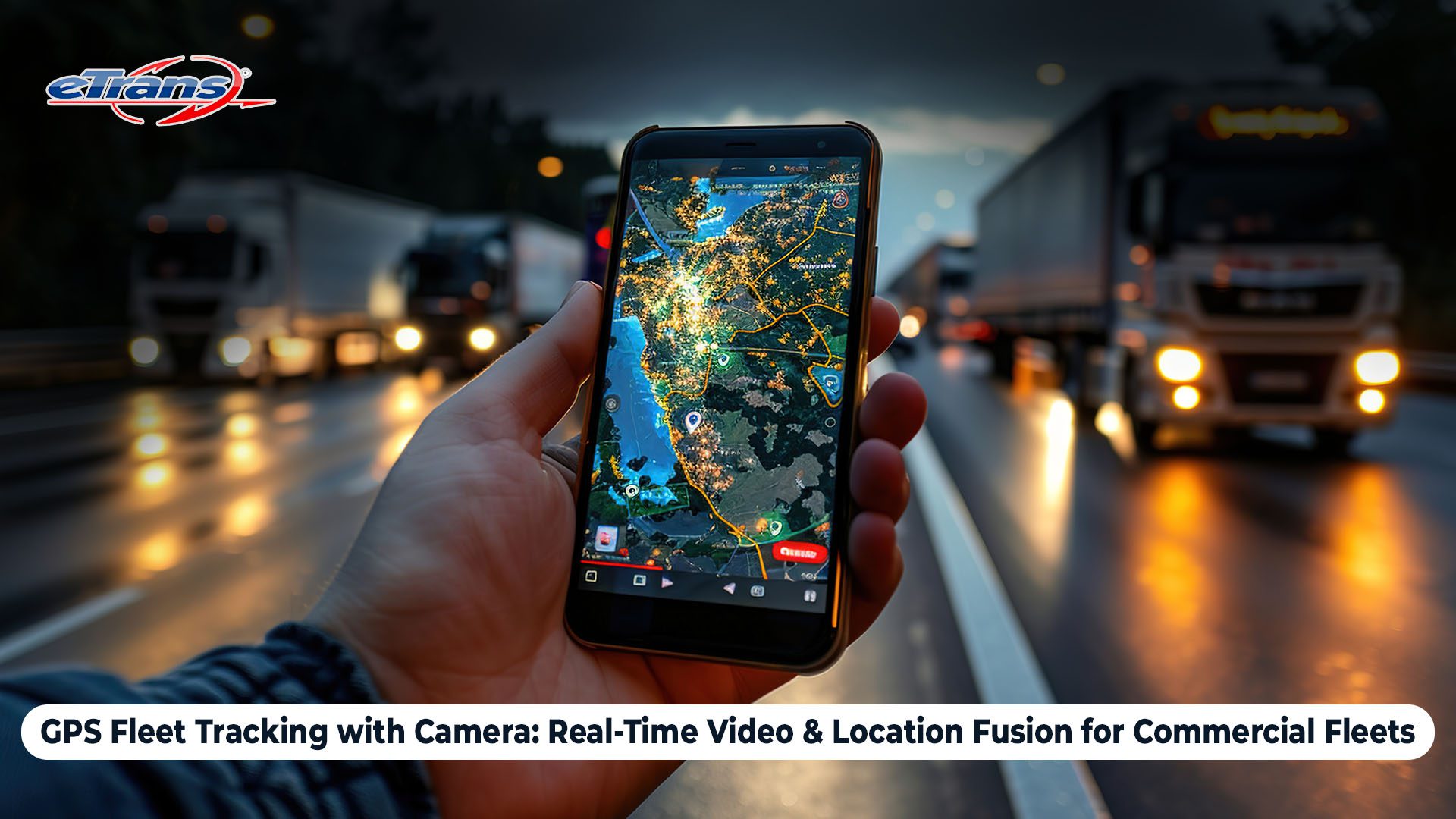If you manage a fleet in India, you already know the daily chaos. Drivers running late, unexplained detours, accident disputes, and that one vehicle that somehow “loses GPS signal” the minute it leaves the yard. Sounds familiar, right? Now imagine having a live window into every vehicle on the road. Watching it move, seeing how your driver’s behaving, and having every incident backed by crystal-clear video evidence. That’s the magic of GPS fleet tracking with a camera.
In today’s logistics-driven India, fleet managers don’t just want dots moving on a map. They want context, the who, what, and why behind every alert. This is where video telematics for fleets changes the game. It doesn’t just tell you where your vehicle is; it shows you exactly what’s happening around it. Think of it as a smart fleet safety solution that merges real-time fleet visibility with AI-powered fleet cameras, a complete digital guardian for your drivers, assets, and reputation.
This blog breaks down how combining GPS tracking with live camera feeds is transforming Indian commercial fleets into safer, smarter, and more efficient operations. You’ll understand how video data syncs with GPS logs, how AI dashcam fleet monitoring works, and why this hybrid setup is the future of fleet telematics in India.
So grab a cup of coffee, because this one’s worth your attention, especially if your fleet’s been operating on faith instead of footage.
Redefining Fleet Visibility with GPS Fleet Tracking and Camera Integration
Gone are the days when fleet management meant calling drivers every hour asking, “Kahan ho?” (Where are you?). GPS fleet tracking with a camera eliminates the guesswork. It’s a visual revolution blending vehicle tracking with a camera to offer full situational awareness.
With traditional GPS, you see your vehicle’s position. With GPS tracking with live camera, you also see what the driver sees. Whether it’s a sudden brake, a near miss, or traffic chaos on Delhi’s Outer Ring Road, you get a front-row seat in real time. Fleet managers across logistics, transport, and delivery sectors are using this dual power to monitor both movement and behaviour.
This fleet video management system helps in reducing fuel misuse, catching unauthorised stops, and ensuring safety compliance. More importantly, it offers visual proof during accidents or customer disputes. No more “he said, she said” drama. The combination of real-time GPS tracking and video telematics for fleets gives your operations transparency like never before.
How Real-Time Video & GPS Data Fusion Works in Fleet Management?
Let’s geek out for a second. The backbone of GPS fleet tracking with a camera is video GPS synchronisation. Here’s how it works: each video frame is tagged with coordinates, speed, and timestamps. The IoT-enabled dashcam continuously records, while the GPS module transmits live positional data.
Both data streams are fused in real time through the fleet video management system, creating a unified timeline of movement and visuals. So if a vehicle suddenly veers off route, the backend shows exactly what the driver was doing at that moment: looking at his phone, avoiding a pothole, or overtaking a truck.
The live feed is stored in the local storage drive, which is accessible from a cloud-based video telematics platform, where fleet operators can access it instantly from any location. This fusion allows them to verify incidents, detect unsafe driving, and even replay journeys frame by frame. For Indian roads where anything can happen (from cows to clueless bikers), real-time fleet visibility powered by GPS + camera fusion is no less than insurance for your peace of mind.
Advantages of Real-Time Video & Location Fusion for Commercial Fleets in India
Here’s where things get exciting. Integrating GPS tracking with a live camera delivers tangible business benefits beyond just “knowing where your vehicle is”.
For starters, fleet owners can cut down on false insurance claims because every incident is recorded with time-stamped video. No more paying for “ghost accidents”. It also improves driver accountability, as operators can review recorded trips for rash driving, idling, or route deviations.
Another major plus? Fuel efficiency. The system’s analytics show engine idle times and aggressive driving patterns that directly impact fuel usage. Fleet managers can coach drivers using driver behaviour analytics to reduce wastage if it is integrated with a Fuel Level Sensor.
In industries like logistics, construction, or intercity transport, this dual system ensures cargo safety, verifies delivery locations, and provides customers with transparent updates. Ultimately, the combination of video telematics for fleets and GPS video surveillance systems enhances safety, productivity, and trust, all while keeping operational costs under control.
The Role of IoT and AI in GPS Fleet Tracking with Camera Systems
Here’s where the system gets brainy. Modern AI dashcam fleet monitoring uses machine learning to detect risky behaviour — drowsy drivers, distracted driving, or even lane violations. These AI-powered fleet cameras process video feeds locally (edge analytics) and send instant alerts to the fleet manager before a potential accident.
Meanwhile, IoT-based telematics camera integration ensures that all devices — GPS trackers, cameras, sensors — communicate seamlessly via cellular or satellite networks. The IoT ecosystem enables predictive analysis, so you can act before an issue escalates.
In India, where driving conditions can go from “highway smooth” to “pothole apocalypse” within minutes, this level of automation is a blessing. The synergy between AI and IoT transforms fleets from reactive to proactive to preventing accidents, optimising routes, and ensuring 24/7 operational continuity.
Addressing Bandwidth, Connectivity, and Data Storage Challenges
Let’s face it — India’s network isn’t always reliable. Even the best systems face hiccups in hilly regions or remote industrial zones. That’s why GPS fleet tracking with camera solutions is designed smartly.
To tackle bandwidth issues, the system uses event-based uploads video footage is transmitted only when incidents like harsh braking or collisions occur. This reduces unnecessary data transfer and costs. Additionally, compressed video formats and edge storage (local SD or SSD) ensure that no critical footage is lost even when connectivity drops.
Meanwhile, cloud-based video telematics architecture takes care of scalability and compliance. Operators can access archives anytime without worrying about storage overload. In a country as large and diverse as India, hybrid cloud setups are key to ensuring both performance and affordability.
Enhancing Safety and Accountability Through Video Evidence
Here’s the real deal: GPS tracking with a live camera isn’t just for fancy dashboards. It’s your strongest defence during disputes, audits, and accidents. Each trip creates a digital trail of video GPS synchronisation, showing precise time, location, and driver response during an event.
This evidence has become invaluable for insurance verification, internal investigations, and driver performance assessments. It also eliminates fraudulent claims, as footage reveals the actual cause of the accident. Transport companies now rely heavily on this data to ensure fair resolutions.
On the human side, drivers also benefit; their innocence is proven instantly if wrongly accused. The culture shifts from blame to accountability. As fleets adopt smart fleet safety solutions, transparency becomes the new norm.
Industry Applications: How Different Indian Fleets Benefit from Video-Enabled Tracking
India’s commercial transport landscape is vast, and every fleet type gains something unique from video telematics for fleets.
- For the entire logistics industry, video telematics is a product primarily getting used for security, safety, driver counselling & training, proof/evidence of incidents, and proactively informs the driver operators immediately for any type of anomalies observed related to driving, etc.
- Passenger transport fleets use it for passenger safety, driver discipline, and emergency visibility.
- Mining and construction fleets use GPS tracking with a camera for in-plant visibility and compliance monitoring.
- Oil and gas transporters rely on it to ensure safety protocols are followed in high-risk zones.
- Even school bus operators are adopting these systems for real-time student safety updates.
From local couriers to heavy-duty hauliers, this technology adapts across industries, proving that visual intelligence isn’t a luxury anymore—it’s a competitive edge.
Regulatory and Data Privacy Considerations in India
Let’s talk about something serious — data privacy. As video telematics grows, so do concerns about surveillance ethics. Fleets must inform drivers about recording policies and seek consent. Footage should be retained only for a defined period and encrypted for protection. The best fleet video management systems use secure cloud servers and role-based access to avoid misuse.
The goal isn’t surveillance—it’s safety. Balancing operational transparency with privacy is crucial. Responsible use of GPS video surveillance systems will determine whether this tech becomes a trust-building asset or a compliance nightmare.
Future Trends: AI-Driven Fleet Intelligence and Predictive Insights
The next wave of fleet telematics in India will be driven by artificial intelligence and 5G connectivity. Imagine a system that not only records but also predicts — alerting you before a driver dozes off. AI-powered fleet cameras will soon integrate with vehicle health monitoring systems, merging safety with maintenance insights.
Cloud-based video telematics will use predictive analytics to forecast delays, optimise driver shifts, and reduce maintenance costs. With 5G enabling ultra-fast transmission, real-time fleet visibility will become instant and seamless. Fleets won’t just react to problems; they’ll anticipate them.
In the near future, every commercial vehicle in India will act like a connected data node — continuously improving itself through machine learning and collective intelligence.
Conclusion: Toward Smarter and Safer Indian Fleets
The future of fleet management is crystal clear — and it’s got a camera lens. GPS fleet tracking with a camera is no longer an optional add-on. It’s an operational necessity for fleets that value safety, accountability, and efficiency.
By merging video with GPS, Indian fleet operators can finally achieve the holy trinity of logistics — visibility, control, and transparency. The fusion empowers managers to make data-driven decisions, improve driver behaviour, and ensure customer trust.
As India’s logistics industry gears up for automation and compliance, video telematics for fleets will play a starring role. So if your fleet’s still running on “location-only” tracking, it’s time to upgrade. Because in 2025 and beyond, the best-managed fleets won’t just know where their vehicles are—they’ll see everything.
Frequently Asked Questions
1. What is GPS fleet tracking with a camera?
It’s a system that combines GPS tracking and live video monitoring to give fleet managers real-time visibility into vehicle location, driver behaviour, and surroundings.
2. How does video telematics help commercial fleets?
It offers visual context for every GPS event, helps prevent fraud, verifies deliveries, and improves safety and accountability across operations.
3. Does GPS fleet tracking with a camera work in areas with poor network coverage?
Yes. Most systems use local storage and event-based uploads, so critical footage is saved and synced once connectivity is restored.
4. Why should fleet management companies adopt video telematics now?
Because it cuts costs, prevents accidents, resolves disputes faster, and keeps you one step ahead in India’s competitive logistics landscape.



